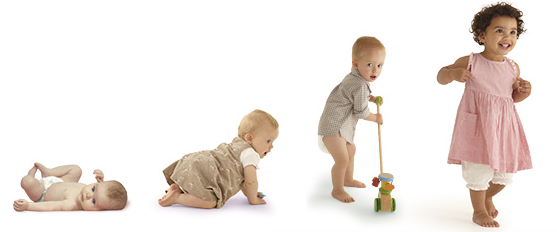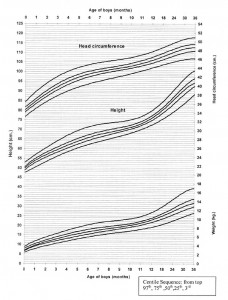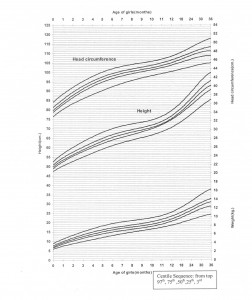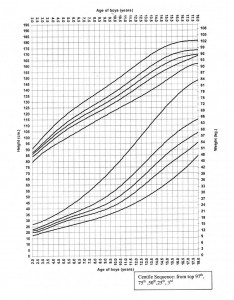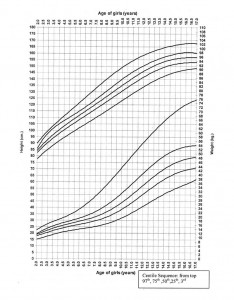| Age | Motor | Speech | Vision and hearing | Social |
|---|---|---|---|---|
| 1–1.5 months | When held upright, holds head erect and steady | Cooes and babbles at parents and people they know | focuses on parents. |
|
| 1.6–2 months | When prone, lifts self by arms; rolls from side to back. | Vocalizes; Cooes (makes vowel-like noises) or babbles. | Focuses on objects as well as adults |
|
| 2.1–4.5 months | Rolls from tummy to side Rests on elbows, lifts head 90 degrees Sits propped up with hands, head steady for short time |
|
Hand regard: following the hand with the eyes.Color vision adult-like. | Serves to practice emerging visual skills.Also observed in blind children. |
| 3 months | Prone: head held up for prolonged periods. No grasp reflex | Makes vowel noises | Follows dangling toy from side to side. Turns head round to sound. Follows adults’ gaze (joint attention).Sensitivity to binocular cues emerges. | Squeals with delight appropriately. Discriminates smile. Smiles often. Laughs at simple things.reaches out for objects |
| 5 months | Holds head steady. Goes for objects and gets them. Objects taken to mouth | Enjoys vocal play; | Noticing colorsAdjusts hand shape to shape of toy before picking up | |
| 6 months | Transfers objects from one hand to the other. Pulls self up to sit and sits erect with supports. Rolls over prone to supine.Palmar grasp of cube hand to hand eye coordination | Double syllable sounds such as ‘mumum’ and ‘dada’; babbles (consonant-vowel combinations) | Localises sound 45 cm lateral to either ear. Visual acuity adult-like (20/20). Sensitivity to pictorial depth cues (those used by artists to indicate depth) emerges. | May show Stranger anxiety |
| 9–10 months | Wiggles and crawls.Sits unsupported. Picks up objects with pincer grasp | Babbles tunefully | Looks for toys dropped | Apprehensive about strangers |
| 1 year | Stands holding furniture. Stands alone for a second or two, then collapses with a bump | 2 or 3 words repeatedly | Drops toys, and watches where they go | Cooperates with dressing, waves goodbye, understands simple commands |
| 18 months | Can walk alone. Picks up toy without falling over. Gets up/down stairs holding onto . Begins to jump with both feet. Can build a tower< of 3 or 4 cubes and throw | ‘Jargon’. Many intelligible words | be able to recognise their favourite songs, and will try to join in. | Demands constant mothering. Drinks from a cup with both hands. Feeds self with a spoon. Most children with autism are diagnosed at this age. |
| 2 years | Able to run. Walks up and down stairs 2 feet per step. Builds tower of 6 cubes | Joins 2–3 words in sentences | Parallel play. Dry by day | |
| 3 years | Goes up stairs 1-foot per step and downstairs 2 feet per step. Copies circle, imitates hand motions and draws man on request. Builds tower of 9 cubes | Constantly asks questions. Speaks in sentences. | Cooperative play. Undresses with assistance. Imaginary companions | |
| 4 years | Goes down stairs one foot per step, skips on one foot. Imitates gate with cubes, copies a cross | Questioning at its height. Many infantile substitutions in speech | Dresses and undresses with assistance. Attends to own toilet needs | |
| 5 years | Skips on both feet and hops. Draws a man and copies a triangle. Gives age | Fluent speech with few infantile substitutions in speech | Dresses and undresses alone | |
| 6 years | Copies a diamond. Knows right from left and number of fingers | Fluent speech |
Milestones by Age
1–4 months
Physical
- Head and chest circumference are nearly equal to the part of the abdomen.
- Head circumference increases approximately 2 cm per month until two months, then increases 1.5 cm per month until four months.
- Increases are an important indication of continued brain growth.
- Continues to breathe using abdominal muscles.
- Posterior fontanelle.
- Anterior fontanelle.
- Skin remains sensitive and easily irritated.
- Legs may appear slightly bowed.
- Cries with tears.
- Gums are red.
- Eyes begin moving together in unison (binocular vision).
- Responds to and thrives on warm, sensitive physical contact and care.
- Expresses discomfort, hunger or thirst.
- Has very poor vision. The infant has trouble focusing on objects and could barely make out images with its eyes.
Motor Development
- Rooting and sucking reflexes are well developed.
- Swallowing reflex and tongue movements are immature; inability to move food to the back of the mouth.
- Grasp reflex.
- Landau reflex appears near the middle of this period; when baby is held in a prone (face down) position, the head is held upright and legs are fully extended.
- Grasps with entire hand; strength insufficient to hold items. Holds hands in an open or semi-open position.
- Movements are large and jerky.
- Raises head and upper body on arms when in a prone position.
- Turns head side to side when in a supine (face up) position; cannot hold head up and line with the body.
- Upper body parts are more active: clasps hands above face, waves arms about, reaches for objects.
- According to Sigmund Freud, the infant is in the oral fixation stage. The oral fixation stage is when the infant begins to root and suck.
4–8 month
Physical
- Head and chest circumferences are basically equal.
- Head circumference increases approximately 1 cm per month until six to seven months, then 0.5 cm per month; head circumference should continue to increase steadily, indicating healthy, ongoing brain growth.
- Posterior fontanelle closing or fully closed.
- Anterior fontanelle.
- Breathing is abdominal; respiration rate depending on activity; rate and patterns vary from infant to infant.
- Teeth may begin to appear, with upper and lower incisors coming in first. Gums may become red and swollen, accompanied by increased drooling, chewing, biting, and mouthing of objects.
- Legs may appear bowed; bowing gradually disappears as infant grows older.
- Fat rolls (“Baby Fat”) appear on thighs, upper arms and neck.
- True eye color is established.
Motor Development
- Reflexive behaviors are changing:
- Blinking reflex is well established
- Sucking reflex becomes voluntary
- Moro reflex disappears
- When lowered suddenly, infant throws out arms as a protective measure.
- Swallowing reflex appears and allows infant to move solid foods from front of mouth to the back for swallowing.
- Picks up objects using finger and thumb (pincer grip).
- Reaches for objects with both arms simultaneously; later reaches with one hand or the other.
- Transfers objects from one hand to the other; grasps object using entire hand (palmar grasp).
- Handles, shakes, and pounds objects; puts everything in mouth.
- Able to hold bottle.
- Sits alone without support, holding head erect, back straightened, and arms propped forward for support
- Pulls self into a crawling position by raising up on arms and drawing knees up beneath the body; rocks back and forth, but generally does not move forward.
- Lifts head when placed on back.
- Can roll over from back or stomach position.
- May accidentally begin scooting backwards when placed on stomach; soon will begin to crawl forward.
- Looks for fallen objects by 7 months
- Plays ‘peek-a-boo’ games
- Cannot understand “no” or “danger”.
8–12 months
Physical
- Respiration rates vary with activity
- Environmental conditions, weather, activity, and clothing still affect variations in body temperature.
- Head and chest circumference remain equal.
- Anterior fontanelle begins to close.
- Continues to use abdominal muscles for breathing.
- More teeth appear, often in the order of two lower incisors then two upper incisors followed by four more incisors and two lower molars but some babies may still be waiting for their first.
- Arm and hands are more developed than feet and legs (cephalocaudal development); hands appear large in proportion to other body parts.
- Legs may continue to appear bowed.
- “Baby Fat” continues to appear on thighs, upper arms and neck.
- Feet appear flat as arch has not yet fully developed.
- Both eyes work in unison (true binocular coordination).
- Can see distant objects (4 to 6 m or 13 to 20 ft away) and points at them.
Motor Development
- Reaches with one hand leading to grasp an offered object or toy.
- Manipulates objects, transferring them from one hand to the other.
- Explores new objects by poking with one finger.
- Uses deliberate pincer grasp to pick up small objects, toys, and finger foods.
- Stacks objects; also places objects inside one another.
- Releases objects or toys by dropping or throwing; cannot intentionally put an object down.
- Beginning to pull self to a standing position.
- Beginning to stand alone, leaning on furniture for support; moves around obstacles by side-stepping.
- Has good balance when sitting; can shift positions without falling.
- Creeps on hands and knees; crawls up and down stairs.
- Walks with adult support, holding onto adult’s hand; may begin to walk alone.
- Watches people, objects, and activities in the immediate environment.
- Responds to hearing tests (voice localization); however, loses interest quickly and, therefore, may be difficult to test formally.
- Follows simple instructions.
- Reaches for toys that are out of reach but visible
- Recognizes objects in reverse
- Drops thing intentionally and repeats and watches object
- Imitates activities like playing drum
- Begins to develop expressive rather than receptive language- child actually responding to what is said to them instead of only receiving and watching the interaction.

